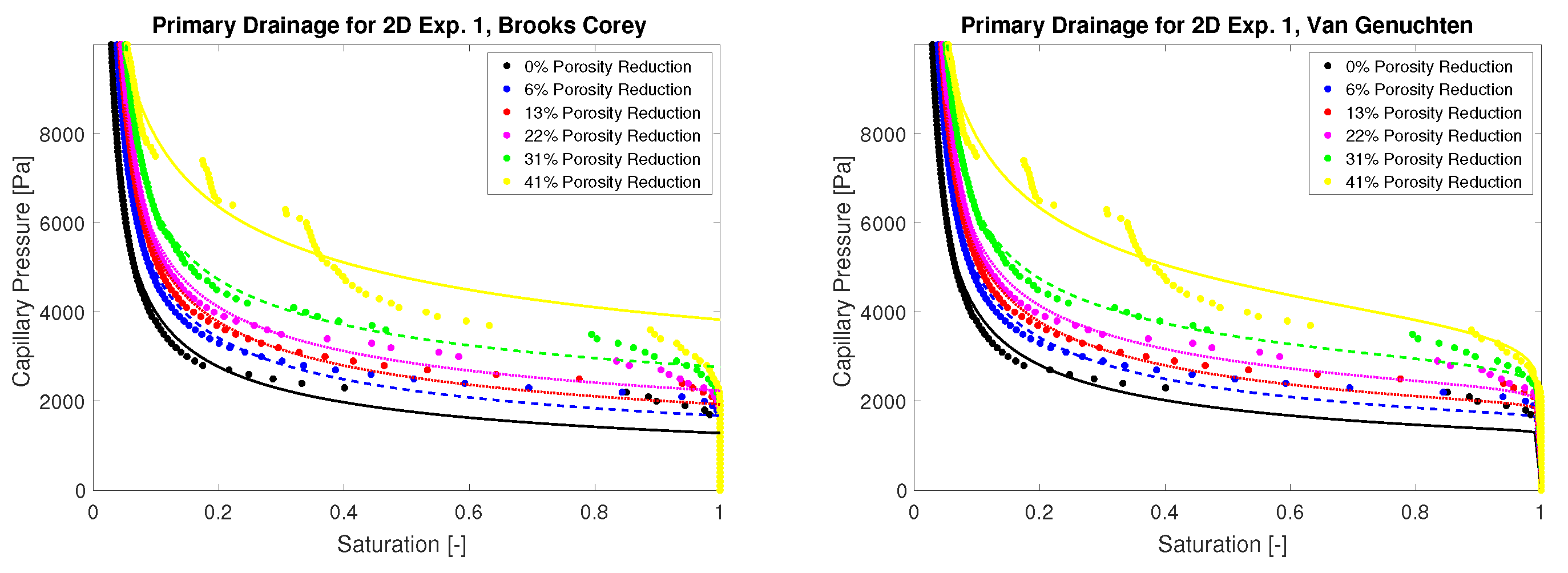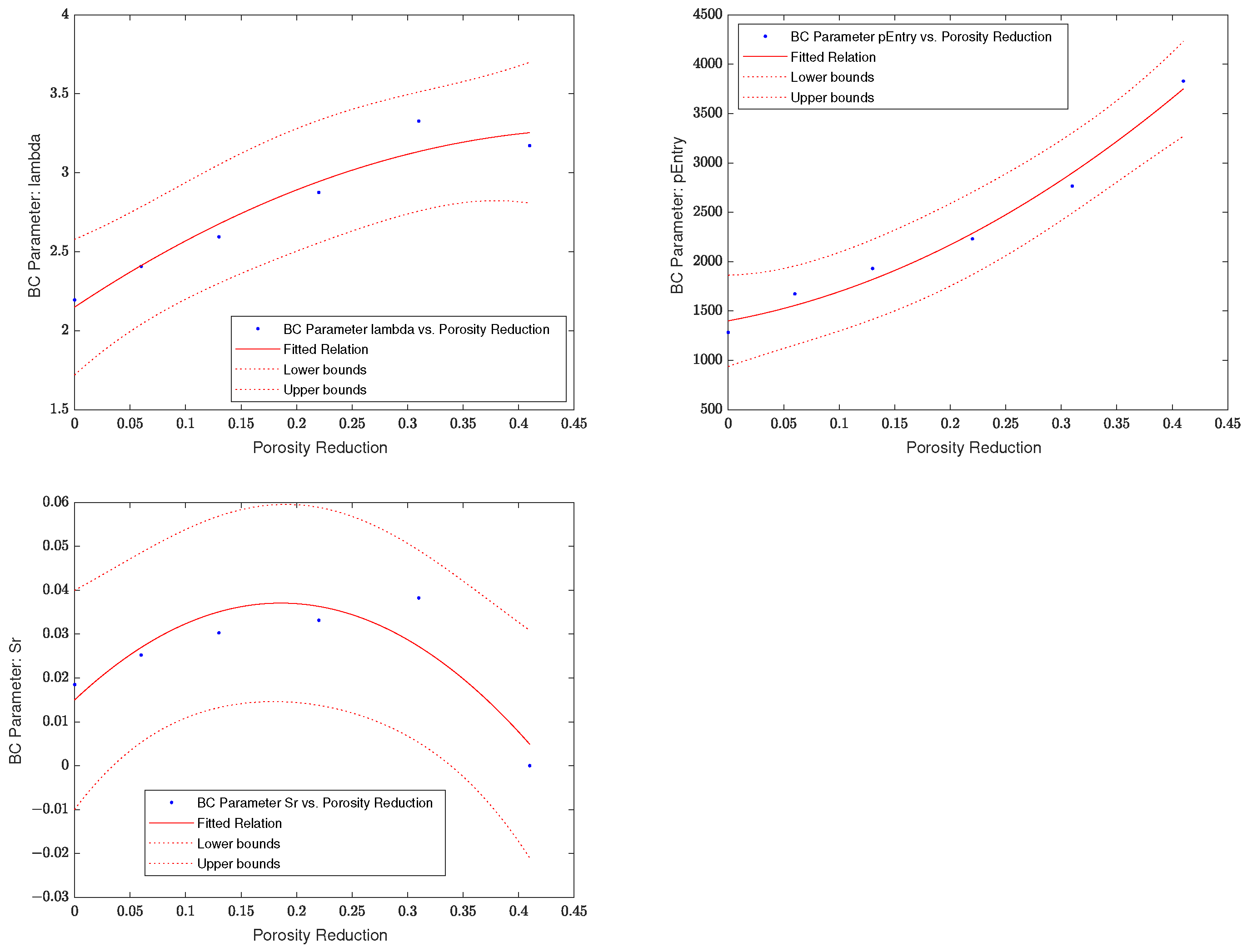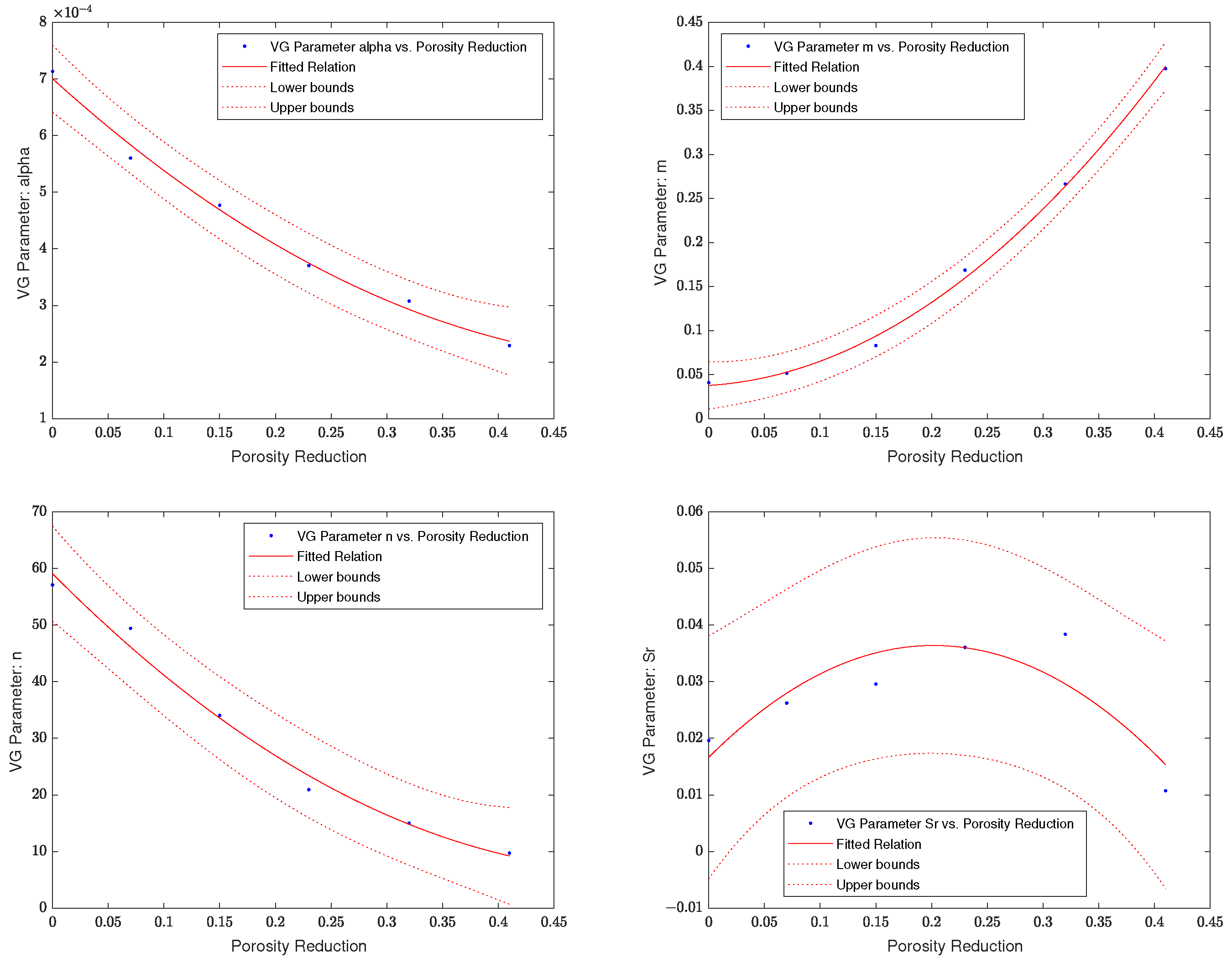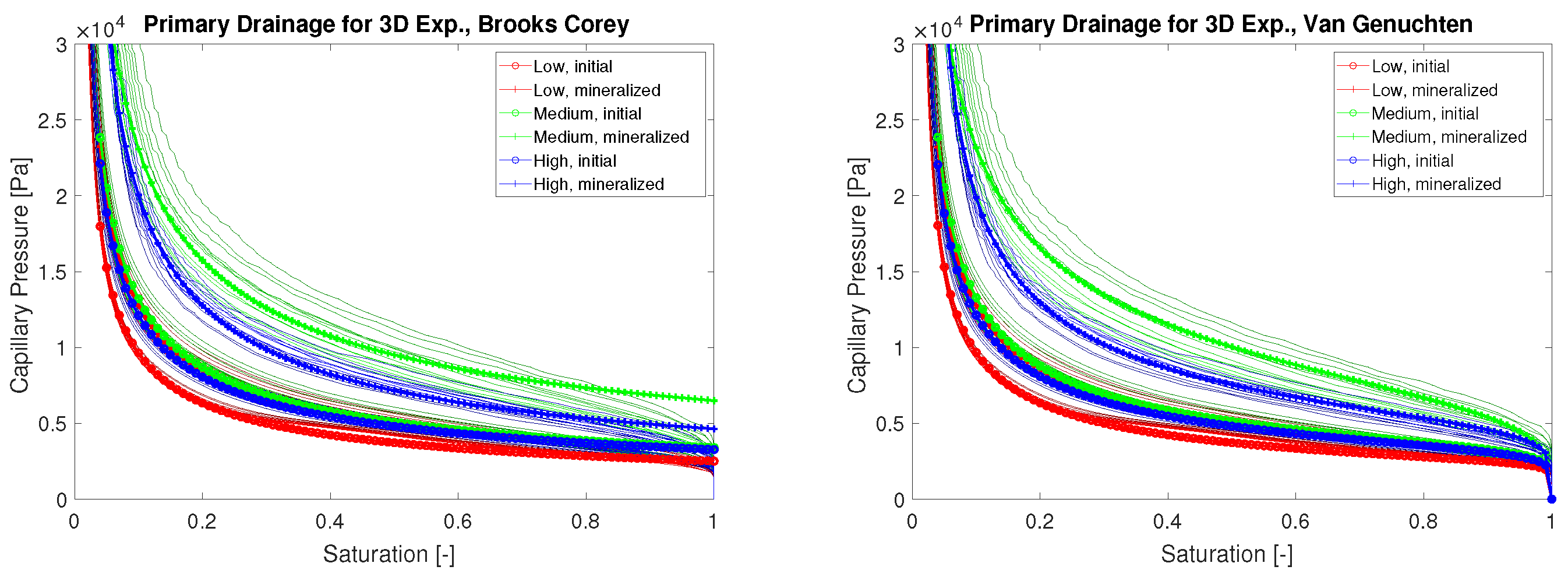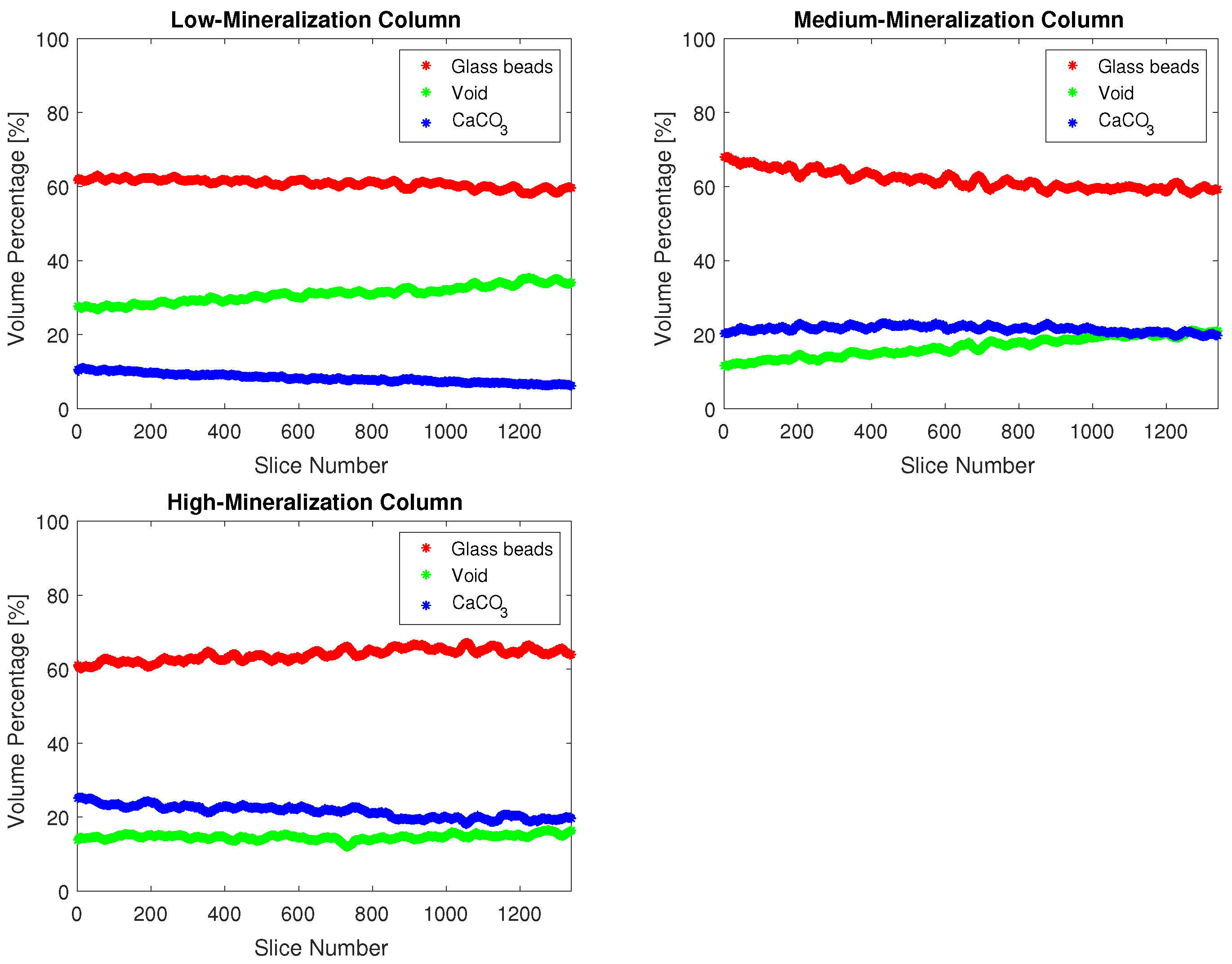1. Introduction
Subsurface fluid storage is an important means to combat climate change by sequestering supercritical CO
2 [
1] or storing energy, e.g., as compressed air, CH
4, or H
2, for coping with intermittent production of renewable sources, such as wind and solar, as well as balancing fluctuating supply and demand [
2]. However, fluids stored underground have the potential to leak through damaged cap rocks or wellbores, posing a threat to other subsurface operations and the environment as well as reducing storage efficiency [
3].
Engineered precipitation of minerals has the potential to seal such leakage pathways. Many minerals may precipitate due to a wide variety of biogeochemical reactions, which can be influenced by engineering measures. The most widely used are carbonate minerals [
4]. In this study, we will focus on the geo-engineered precipitation of induced calcium carbonate precipitation (ICP), which, among many other applications, has been demonstrated to have immense potential not only for subsurface engineering, but also for novel construction materials, soil stabilization, or remediation applications [
4,
5,
6,
7,
8].
ICP reduces the porosity, permeability, and, likely, two-phase flow parameters of a porous medium by the precipitation of calcium carbonate, creating subsurface barriers for flow. Such barriers have the potential to remediate damaged cap rocks or leaky well cements in order to increase storage security by blocking potential leakage pathways. Most applications of ICP rely on urea hydrolysis by microbes or plant-based urease extracts to promote carbonate precipitation within porous media [
9]. Urease is an abundant and well-studied enzyme [
10], and urea is a relatively cheap reactant, which might explain the popularity of ureolytically induced carbonate precipitation. However, other metabolisms may also lead to the precipitation of carbonates [
5]. In the presence of sufficient concentrations of calcium, this results in the overall reaction:
Several large- or field-scale demonstrations of ICP have been completed with the aims of modifying soil properties, e.g., [
11,
12,
13,
14,
15,
16], or mitigating leakage in deeper subsurface, e.g., [
8,
17,
18,
19,
20,
21]. Often, these demonstrations were assisted by numerical investigations, e.g., [
14,
22,
23]. Additionally, numerical investigations are used to study the feasibility of leakage mitigation in the deep subsurface, such as [
24,
25]. While ICP is widely proposed as a leakage mitigation technology, only a few field-scale investigations were actually conducted in the relevant two-phase flow conditions. The first step in the experimental investigation of two-phase flow was the lab-scale investigation of microbial ICP in [
26]. The field application of Kirkland et al. [
27] goes one step further, as it successfully applied ICP to seal leakage pathways in the presence of a CO
2 phase at the field scale.
However, most models developed of ICP assume full saturation of the porous medium with an aqueous phase [
28,
29,
30,
31,
32,
33]. Most recently developed models, especially those explicitly designed with leakage mitigation in mind, consider the impact of ICP on the porous medium’s hydraulic properties, but this is usually limited to predicting the permeability change based on the change in porosity. Even those models of ICP that consider two-phase flow, e.g., [
34,
35,
36], generally do not account for ICP-induced changes of two-phase flow parameters, such as the capillary pressure–saturation relation. A simplistic approach is used in [
34] to account for ICP changing capillary pressure–saturation relations using Leverett scaling [
37]. However, even in those instances where an impact of ICP on hydraulic parameters is considered in numerical models, the parameterizations are usually rather simplistic. Permeability changes are mostly accounted for using a power law, e.g., [
34,
35,
36], or relations based on the Kozeny–Carman equation, e.g., [
32,
33].
The effect of ICP on porosity–permeability relations has become the target of experimental studies with the aim of understanding the effect of ICP or similar precipitation processes at the pore scale [
38,
39], expanding on previous microfluidic studies of ICP, e.g., [
40,
41,
42,
43]. Both [
38] and [
39] investigated porosity–permeability relations, observing the porosity change by microscopy and calculating the permeability change from pressure measurements. However, these quasi-2D geometries allow for convenient and time-resolved imaging but usually cannot represent realistic 3D geometries as they occur in real porous media [
44]. Recently, porosity–permeability relations, not only of ICP, have been studied in 3D systems. The use of micro X-ray computed tomography (µXRCT) to observe the porosity change has been conducted, e.g., [
45,
46]. µXRCT eliminates the geometrical constraints of 2D microfluidic systems, providing more realistic porosity–permeability relations for use in predictive numerical models. As a recent example, ref. [
47] examines the flow properties of various sandstones by using pore-network modeling on pore networks extracted from µXRCT images. Experimentally, the impact of pore-geometry changes has been investigated in, e.g., carbonate dissolution in [
48]. Similarly, ref. [
49] investigated the effect of CO
2 injection into carbonate rocks on multi-phase flow properties.
The respective two- or multi-phase flow relations, such as capillary pressure–saturation or relative-permeability-saturation relations, have not yet been studied in detail, even though they are arguably of equal importance for the understanding and numerical modeling of leakage mitigation or other reservoir applications. Capillary pressure
is generally defined as the difference between the non-wetting phase pressure
and the wetting phase pressure
:
On the scale of a single pore throat or capillary tube with radius
, the individual capillary pressure can be calculated based on the Young–Laplace equation:
where
is the interfacial tension between the wetting and non-wetting fluids, and
is the contact angle between the fluid–fluid interface and the solid surface. Based on the bundle of capillary tubes model, which simplifies a porous medium into a bundle of parallel tubes, e.g., [
50], and the Young–Laplace equation, which shows the effect of radius on capillary pressure, it can be expected that any precipitation within porous media that necessarily, at least locally, reduces pore or pore-throat radii, and thereby also the capillary pressure in this pore or pore throat, is likely to influence capillary pressure–saturation relations on the representative elementary volume (REV) scale. For porous media in general, however, consideration of individual pores becomes impractical, necessitating the use of alternative descriptions, e.g., algebraic relations, or based on assumptions of bundles of capillary tubes through which the wetting phase saturation for a given capillary pressure is determined by integration, as, e.g., completed for dynamic conditions by [
51]. The result of this approach is then a relation between the wetting phase saturation and the capillary pressure, which represents Equation (
3) on a larger scale using averaging over a REV. Such REV-scale capillary pressure–saturation relations are widely used in numerical modeling of two- or multi-phase flow in porous media. The commonly used relations for modeling are of the Brooks–Corey [
52] and Van Genuchten types [
53]. The relation according to Brooks–Corey [
52] is:
and the relation according to Van Genuchten is:
both provide an equation to estimate
based on the effective wetting phase saturation
, which can be calculated based on the current and residual water saturations
and
, respectively:
For the Brooks–Corey relation, the additional parameters are the entry pressure
and the parameter
. For the Van Genuchten relation, the parameters are
,
m, and
n. The Van Genuchten parameter
m is sometimes expressed as
for theoretical considerations, enabling complete integration of Mualem’s equation [
54].
We use two different experimental setups as the basis for this: the 2D microfluidic experiments of [
38], which provide excellent possibilities for observation by optical microscopy with a resulting high temporal resolution but at limited realisticity of the porous medium, and the 3D sintered glass-bead columns, which offer more realistic porous media; however, this is more difficult to image as it requires the much more time-consuming lab-based µXRCT scanning as the imaging method, which does not allow for temporal resolution within experiments. Both setups were mineralized using enzymatically induced calcium carbonate precipitation (EICP), and, while the 2D microfluidic cells were continuously imaged, the 3D columns could only be imaged after mineralization. The columns with an initial average porosity ranging from 36% to 39% were thus mineralized to various degrees to achieve different porosity reductions. The decision to stop the mineralization treatment was based on the increase in differential pressure to
,
, and
at a reduced flow rate, resulting in a 21, 56, and 59% porosity reduction for the low, medium, and high mineralizations. The mineralized 3D columns were then scanned in a custom µXRCT device with a single micrometer resolution, as described in detail in [
55]. The reconstructed images of the 3D columns were finally segmented into three phases: glass, void, and precipitate. See the published datasets [
56,
57,
58,
59]. The continuously imaged 2D microfluidic cells were selected at various steps of porosity reduction and segmented into solid and pore space; the actual pore geometry was reconstructed based on previous investigations [
38]. See also the dataset [
60].
To capture and later upscale what are essentially pore-scale displacement processes, it is important to investigate the scale of the pores. Direct pore-scale modeling using the segmented images directly, e.g., by [
61,
62], or, in general, methods not requiring morphological assumptions, e.g., [
63,
64], result in the most realistic results, capturing the effects of sub-pore-scale surface roughness or additional sub-pore-scale complexity, such as, e.g., the heterogeneous distribution of contact angles [
65]. However, direct pore-scale simulations on the actual geometry as determined by the XRCT images of the 3D samples, or even the comparatively small geometry of the 2D samples, are likely prohibitive in computational cost, especially when using the entire domain or large parts of it. Thus, there is a need to simplify the imaged geometry without sacrificing too much of the detailed geometrical knowledge of the image data. This can be achieved by extracting a pore network (PN) from the available segmented images. While a PN represents a simplified geometry that, obviously, cannot represent every sub-pore-scale detail, by choosing angular pore-body and pore-throat geometry, which better approximate the angular pore geometry of our samples, wetting fluid flow is possible even after the non-wetting fluid has invaded a location due to wetting fluid remaining connected via the corners [
50]. This will account for some, but not all, sub-pore-scale detail, but we prefer investigating a larger domain over having the highest resolution, as our aim is ultimately to upscale to the REV-scale, a transition in which some detail of even the pore scale might be lost. Pore-network modeling (PNM) combines a relatively realistic, though simplified, version of the pore-scale geometry of a porous medium, idealized into a network of pore bodies linked by pore throats [
50,
66]. PNs represent a scale between the exact pore scale and coarser scales, and PNM can be a convenient tool for determining coarser-scale, upscaled properties, such as, e.g., intrinsic permeability, but also multi-phase flow properties [
46,
50,
67,
68,
69]. PNM has been used to investigate the impact of simultaneous mineral dissolution and precipitation on porosity–permeability relations for certain hypothetical scenarios of pore-geometry change in, e.g., [
70]. PNM has also been used to investigate reactive transport affecting pore geometry by, e.g., mineral dissolution and precipitation [
71] or biofilm growth [
72,
73]. Moreover, in the context of ICP, PNM has been used, e.g., to determine the interplay of pore-scale transport and reactions in [
74].
We extracted PNs from the segmented images of both the complete 2D and 13 length-wise sections of each of the 3D samples, using the complete diameter at the given porosity reductions. This way, we ensured that our simulation domains are large enough to be considered a representative elementary volume (REV) while retaining a geometry that is as realistic as possible. We prefer using PNs extracted from the actual geometry over PNs created on a structured lattice based on a statistical analysis of the actual geometries, as proposed by, e.g., [
75]. On the extracted PN, we evaluate capillary pressure–saturation curves by performing numerical primary drainage experiments using water and air as the wetting and non-wetting phase to determine the effect of EICP on the capillary pressure–saturation relation. Both the Brooks–Corey [
52] and Van Genuchten [
53] types of capillary pressure–saturation relations are fitted to the curves obtained by the numerical primary drainage experiments.
Finally, we study the impact of the porosity reduction due to precipitation on the parameters of both the Brooks–Corey (
,
,
) and the Van Genuchten (
,
m,
n,
) capillary pressure–saturation relations to find suitable parameterizations for implementation in numerical models describing ICP. In general, we expect to observe an increase in capillary pressure for a given saturation and a decrease in porosity during mineralization with ICP as the precipitates reduce the space available for the fluids and reduce the pore-throat radii for which Equation (
3) predicts higher capillary pressures at given saturations. Additionally, Leverett scaling [
37] suggests increased capillary pressure for a given saturation, when the porosity and, therefore, also the permeability are reduced. For constant fluid and fluid–solid-interaction properties, Leverett scaling results in scaling the capillary pressure for the reference condition
by a factor determined by the changes in porosity
and permeability
K:
where
is the capillary pressure for the porosity change
, and
and
are the initial values of permeability and porosity. A problem with using Leverett scaling is that it also requires a description of the effect of ICP on the permeability
K, which is not a trivial task, as observed by several experimental studies, e.g., [
38,
39,
41].
In this study, we attempt the first exploration of the effect of ICP on capillary pressure–saturation relations, combining experimental observations in microfluidic systems as a base and PNM as a method to evaluate the effect of the observed pore-geometry changes due to ICP on the capillary pressure–saturation curves. Investigating different degrees of porosity reduction allows us to propose capillary pressure–saturation–porosity relations that, on an REV scale, describe the effects of ICP on capillary pressure. This enables us to describe such effects on the REV-scale models of ICP, which are commonly used to design, monitor, and assess the real-world applications of ICP, thereby improving the predictive capabilities of such models for leakage mitigation scenarios, which are a common scenario for the use of ICP. We believe this study is a crucial step toward more realistic models of ICP in the context of subsurface leakage mitigation applications and an improved general understanding of the impact of ICP on two- or multi-phase flow.
4. Discussion
Both the 2D and 3D experiments investigated showed a noticeable increase in capillary pressure for a given saturation due to the precipitation of calcium carbonate during EICP. Qualitatively, both the 2D and the 3D experiments show similar tendencies, but, for the 3D systems, the effects are more difficult to quantify and parameterize. We suspect that this is mainly due to two reasons: the initial unmineralized 3D samples not being as identical as the 2D samples and having only the initial and the final geometries without further temporal resolution. However, the 2D samples are limited to a 2D geometry, which results not only in high initial porosity, much higher than the porosities of most field-relevant porous media but also in an artificially constricted 2D flow field in which even a few pore throats reduced in diameter may already significantly reduce flow or increase the sample’s capillary entry pressure. Thus, the relations fitted to the 2D samples are likely not representative of realistic porous media; however, they provide insight into development during mineralization over time, data that were not available for our more realistic 3D samples.
The changes in capillary pressure–saturation relations due to EICP manifest in an increase in the entry pressure of up to a factor of almost 2 for the 3D and for the 2D samples. For the 2D samples, the parameter increased with reducing porosity; for the 3D samples, increased for two samples, while it decreased for the third sample. Similarly, for a Van Genuchten-type parameterization, the parameter m is increased by EICP for the 2D samples by up to a factor of 10. The parameter decreased by factors of up to 2.2 for the 3D and 3.1 for the 2D samples, while n decreased by a factor of up to 2.0 for the 3D and 5.8 for the 2D samples. For both parameterizations, the residual saturation changes only slightly. However, for all samples investigated, is small even for highly mineralized geometries. This could be an artifact of the relatively regular, homogeneous initial porous media studied, with the 2D samples having a constant height and the 3D samples consisting of sintered, monodisperse-sized glass beads. The low residual saturations obtained in this study using PNM can be confirmed using direct numerical pore-scale modeling directly on the segmented images to avoid potential artifacts due to the simplification in pore geometry that PNM relies on. Especially for the initial unmineralized samples, the 13 sections seem to be sufficiently large to be considered an REV, as the parameters determined for the average over the entire 3D sample are relatively similar compared to the parameters determined for the individual sections. Even for mineralized samples, the amount of heterogeneity is still relatively low, at least that which can be captured by the resolutions used. Further, disconnected pore volumes cannot be accounted for in the pore-network model used due to the numerical instabilities resulting from disconnected networks, due to which any disconnected pores needed to be removed. Such disconnection of pores was not observed for the 2D samples and only for a limited amount of pores for the 3D samples. However, for the 3D samples, where some pores became disconnected, the may likely be underestimated, but, to complicate the issue further, disconnection in our study may also be an artifact of the resolution in the case that the remaining pore throats were reduced to diameters smaller than the resolutions of the µXRCT scans, which would result in an assumption of disconnection in our analysis while remaining connected in reality. While the changes in the parameter values of the Van Genuchten relation with reducing porosity have identical trends with reducing porosity for both the 2D and 3D column samples, the differences between, e.g., the high- and medium-mineralization 3D samples make a description of this change based solely on the porosity change impossible. Including the effect of ICP on pore-scale parameters, such as, e.g., pore-size distributions, would likely help explain the effects of ICP on the capillary pressure–saturation curves observed. However, pore-size distributions and other pore-scale parameters are not available on the REV scale, at which real ICP applications will ultimately have to be modeled, adding not only an additional layer of complexity but also the need to upscale the effects of ICP from the pore scale to the REV scale. Including an increased number of REV-scale parameters, such as, e.g., specific surface areas, may potentially improve the predictability of relations for REV-scale capillary pressure–saturation relations of porous media being mineralized using ICP. Then again, such parameters, or their change due to ICP, are themselves difficult to define on the REV scale alone and must be upscaled themselves from the pore scale. Surface areas can directly determine the specific surface areas or similar parameters based on the segmented images.
With our current experimental data, we are reluctant to claim that we determined the final parameterization of the effect of ICP on REV-scale capillary pressure–saturation relations. However, what we can show is that Leverett scaling is not accurate in describing the changes in the capillary pressure–saturation relations due to ICP, especially for the 2D samples, for which ICP completely alters the capillary pressure–saturation relations (see
Table 1 and
Table 2). As seen in Equation (
7), Leverett scaling results in a scaling of the capillary pressure–saturation relation by a constant factor, which does not fit the experimental observations of a changing Brooks–Corey parameter
or Van Genuchten parameters
m and
n (see
Table 5 and
Table 6). To some extent, however, Leverett scaling may still be a simple and good enough parameterization of the effect of ICP on the capillary pressure–saturation relations. In the 3D samples, which provide a more realistic initial geometry, the change in, e.g., the Brooks–Corey relation’s parameters
is small, <10%, and, for some samples,
increased, while, for others,
decreased with reducing porosity, creating some uncertainty about how to reliably predict the effect of ICP on a porous medium’s
. Thus, only the parameter
changed significantly, which can be represented using Leverett scaling. However, the changes in capillary pressure and
, in particular, are much smaller than predicted by Leverett scaling based on experimentally determined porosities and permeabilities. For the high-mineralization sample, Leverett scaling using Equation (
7) overestimates the increase in capillary pressure by more than one order of magnitude. To some extent, relations similar to Leverett scaling might still be a simple and good enough parameterization of the effect of ICP on the capillary pressure–saturation relations, as
seems to be the parameter most influenced by ICP. The changes in
are, however, variable and, for the 3D samples, cannot be described solely based on the porosity reduction, which further complicates the description. Looking at the data of individual sections of the 3D samples, the variability increases, and the porosity reduction has even less predictive potential.





